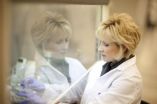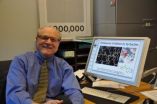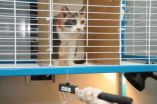(Press-News.org) Performing sensitive biological experiments is always a delicate affair. Few researchers, however, contend with the challenges faced by Cheryl Nickerson, whose working laboratory aboard the International Space Station (ISS) is located hundreds of miles above the Earth, traveling at some 17,000 miles per hour.
Nickerson, a microbiologist at Arizona State University's Biodesign Institute, is using the ISS platform to pursue new research into the effects of microgravity on disease-causing organisms.
Nickerson presented her research findings and charted the course for future investigations aboard the ISS on February 18 at the 2013 annual meeting for the American Association for the Advancement of Science, held in Boston, Mass. Her talk, entitled "Microgravity: A Novel Tool for Advances in Biomedical Research," is part of a special session devoted to ISS science.
"One important focus of my research is to use the microgravity environment of spaceflight as an innovative biomedical research platform. We seek to unveil novel cellular and molecular mechanisms related to infectious disease progression that cannot be observed here on Earth, and to translate our findings to novel strategies for treatment and prevention."
During an earlier series of NASA space shuttle and ground-based experiments, Nickerson and her team made a startling discovery. Spaceflight culture increased the disease-causing potential (virulence) of the foodborne pathogen Salmonella, yet many of the genes known to be important for its virulence were not turned on and off as expected when this organism is grown on Earth. Understanding how this switching is regulated may be useful for designing targeted strategies to prevent infection.
For NASA, Nickerson's findings were revelatory, given their implications for the health of astronauts on extended spaceflight missions. Already faced with the potential for compromised immunity induced by the rigors of space travel, astronauts may have to further contend with the threat of disease-causing microbes with amped-up infectious abilities. A more thorough understanding of infectious processes and host responses under these conditions is therefore vital for the design of therapeutics and other methods of limiting vulnerability for those on space missions.
The story however, doesn't end there. Further research by Nickerson's team pointed to important implications for the understanding of health and disease on Earth. Her team, including NASA scientists, showed that one of the central factors affecting the behavior of pathogenic cells is the physical force produced by the movement of fluid over a bacterial cell's sensitive surface. This property, known as fluid shear, helps modulate a broad range of cell behaviors, provoking changes in cell morphology, virulence, and global alterations in gene expression, in pathogens like Salmonella.
"There are conditions that are encountered by pathogens during the infection process in the human body that are relevant to conditions that these same organisms experience when cultured in spaceflight. By studying the effect of spaceflight on the disease-causing potential of major pathogens like Salmonella, we may be able to provide insight into infectious disease mechanisms that cannot be attained using traditional experimental approaches on Earth, where gravity can mask key cellular responses," says Nickerson
Nickerson's spaceflight studies also pinpointed an evolutionarily conserved protein—called Hfq—which appears to act as a global regulator of gene responses to spaceflight conditions. Further research by her team established that Hfq is a central mediator in the spaceflight-induced responses of other bacterial pathogens, including Pseudomonas aeruginosa, thus representing the first spaceflight-induced regulator acting across bacterial species.
Nickerson's examination of the post-spaceflight alterations in bacterial behavior made use of microarray technology, which allows analysis of gene expression for the entire 4.8 million base pairs found in Salmonella's circular chromosome. Data revealed that 167 distinct genes and 73 proteins had been altered during growth under microgravity conditions, including (but not limited to) virulence-associated genes. Of the 167 genes undergoing up- or down-regulation in response to spaceflight, one third were under the control of the Hfq master regulator protein.
These microgravity studies open a new window into the infectious disease mechanisms of Salmonella, an aggressive pathogen responsible for infecting an estimated 94 million people globally and causing 155,000 deaths annually. In the U.S. alone, more than 40,000 cases of Salmonellosis are reported annually, resulting in at least 500 deaths, and health care costs in excess of $50 million. However, only a small percentage of infections with Salmonella are reported, and the estimated two to four million cases of Salmonella-induced gastroenteritis which occur in the United States each year constitute a significant economic loss of productive work time, reported to exceed $2 billion annually.
While Salmonella has been a pathogen of choice for a broad range of spaceflight investigations, Nickerson stresses that her findings have spaceflight and Earth-based implications. Her confidence is based on her team's work showing that microgravity culture also uniquely alters gene expression and pathogenesis-related responses in other microorganisms.
Nickerson emphasizes that the ISS provides an unprecedented opportunity to study the infection process under microgravity conditions, enabling advances in our understanding of microbial gene expression and accompanying host responses during infection in fine-grained detail. This novel approach holds the potential to identify new classes of genes and proteins associated with infection and disease not possible using traditional experimental conditions on Earth, where the force of gravity can mask certain cellular responses. Further, experiments aboard the ISS will permit the study of microbial transitions and cellular responses to infection over a prolonged time frame - an important advance not available during shuttle-based experiments.
Microgravity research may provide an opportunity to identify novel targets for vaccine development and the Nickerson team, in collaboration with Roy Curtiss, director of the Biodesign Institute's Center for Infectious Diseases and Vaccinology has been working toward this goal. Based on previous findings, the scientists hypothesized that results from microgravity experiments might be used to facilitate vaccine development on Earth.
In a recent spaceflight experiment aboard space shuttle mission STS-135, the team flew a genetically modified Salmonella-based anti-pneumoccal vaccine that was developed in the Curtiss lab. By understanding the effect of microgravity culture on the gene expression and immunogenicity of the vaccine strain, their goal is to genetically modify the strain back on Earth to enhance its ability to confer a protective immune response against pneumococcal pneumonia.
"Recognizing that the spaceflight environment imparts a unique signal capable of modifying Salmonella virulence, we will use this same principle in an effort to enhance the protective immune response of the recombinant attenuated Salmonella vaccine strain," Nickerson says.
Nickerson's space-based microgravity experiments are carried out in conjunction with simultaneous Earth-based controls housed in the same hardware as those in orbit, to compare the behavior of bacterial cells under normal Earth gravity. Additional information is also provided using Earth-based cell cultures which are subjected to a kind of simulated microgravity, produced by culturing cells in a rotating wall vessel bioreactor (RWV), a device designed by NASA engineers to replicate aspects of cell culture in the spaceflight environment.
Back at ASU, RWV reactor experiments were conducted by Nickerson and her team to help confirm that Hfq plays a central regulatory role in the Salmonella response to spaceflight conditions. Nickerson has also used this RWV technology to grow three dimensional (3-D) cell culture models that mimic key aspects of the structure and function of tissues in the body. These 3-D models are being used in the Nickerson lab as human surrogates to provide novel insight into the infectious disease process not obtainable by conventional approaches and for drug/therapeutic testing and development for treatment and prevention.
Nickerson also focuses research efforts on determining the entire repertoire of environmental factors that may influence bacterial response to spaceflight culture. For example, she found that the ion concentration in the cell culture media played a key role in the resulting effect of spaceflight on Salmonella virulence. Using the RWV, she was able to identify specific salts that may be responsible for this effect.
Nickerson's long list of firsts (first study to examine the effect of spaceflight on the virulence of a pathogen, first to obtain the entire gene expression response of a bacterium to spaceflight, first to profile the infection process in human cells in spaceflight, first identification of a spaceflight-responsive global gene regulator acting across bacterial species), will soon be augmented with a new experiment, that will be flown on SpaceX Dragon slated for the ISS later this year. Nicknamed PHOENIX, the project will mark the first time a whole, living organism—in this case a nematode—will be infected with a pathogen and simultaneously monitored in real time during the infection process under microgravity conditions.
This and future studies aboard ISS will almost certainly deepen science's understanding of the molecular and cellular cues underlying pathogenic virulence and open a new chapter in the understanding of health and disease to benefit the general public.
"It is exciting to me that our work to discover how to keep astronauts healthy during spaceflight may translate into novel ways to prevent infectious diseases here on Earth," Nickerson says.
INFORMATION:
Written by:
Science Writer: The Biodesign Institute
Richard.Harth@asu.edu
International space station plays host to innovative infectious disease research
2013-02-20
ELSE PRESS RELEASES FROM THIS DATE:
UCLA study suggests link between untreated depression, response to shingles vaccine
2013-02-20
Can an individual's state of mind effect how well a vaccine may work? In the case of seniors and shingles, the answer is yes.
Reporting in the current online edition of the journal Clinical Infectious Diseases, Dr. Michael Irwin, a professor of psychiatry at the Semel Institute for Neuroscience and Human Behavior at UCLA, demonstrates a link between untreated depression in older adults and decreased effectiveness of the herpes zoster —or shingles — vaccine.
Shingles is a painful, blistering skin rash that can last for months or even years. It's caused by the varicella–zoster ...
BUSM authors propose potential epigenetic mechanisms for improved cancer therapy
2013-02-20
(Boston) – A review article by researchers at Boston University School of Medicine (BUSM) proposes a new epigenetic hypothesis linked to tumor production and novel ideas about what causes progenitor cells to develop into cancer cells. Published in the February 2013 issue of Epigenomics, the article provides examples of how epigenetic drug treatments could be beneficial in treating cancers while also decreasing the likelihood of cancer relapse.
The article was written by researchers at the Boston University Cancer Center. Sibaji Sarkar, PhD, adjunct instructor of medicine ...
Infants in poverty show different physiological vulnerabilities to the care-giving environment
2013-02-20
Some infants raised in poverty exhibit physical traits that make them more vulnerable to poor caregiving, according to new research published in Psychological Science, a journal of the Association for Psychological Science. The combination of physiological vulnerability and poor caregiving may lead these children to show increased problem behaviors later in childhood.
For infants growing up in poverty, the ability to adapt and regulate — both biologically and behaviorally — in response to various environmental pressures seems to be critical for successful development.
To ...
Rewriting a receptor's role
2013-02-20
In a pair of new papers, researchers at the University of California, San Diego School of Medicine and the Royal Netherlands Academy of Arts and Sciences upend a long-held view about the basic functioning of a key receptor molecule involved in signaling between neurons, and describe how a compound linked to Alzheimer's disease impacts that receptor and weakens synaptic connections between brain cells.
The findings are published in the Feb. 18 early edition of the Proceedings of the National Academy of Sciences.
Long the object of study, the NMDA receptor is located ...
IU research: Rock-paper-scissors a parable for cycles in finance, fashion, politics and more
2013-02-20
BLOOMINGTON, Ind. -- Using a grown-up version of the rock-paper-scissors game, Indiana University cognitive scientists offer a new theory of the group dynamics that arise in situations as varied as cycles of fashion, fluctuations of financial markets, eBay bidding wars and political campaign strategies.
In a study written about this week in PLOS ONE, the researchers analyzed situations in which each person's decision depends on what they think other people will decide, looking at the riddle of "what you think I think you think I think."
What they found, said Seth Frey, ...
New compound holds high promise in battling kidney cancer
2013-02-20
RIVERSIDE, Calif. — Chemists at the University of California, Riverside have developed a compound that holds much promise in the laboratory in fighting renal (kidney) cancer.
Named TIR-199, the compound targets the "proteasome," a cellular complex in kidney cancer cells, similar to the way the drug bortezomib, approved by the Food and Drug Administration, targets and inhibits the proteasome in multiple myeloma cells, a cancer coming from bone marrow.
Michael Pirrung, a distinguished professor of chemistry at UC Riverside, announced the development of TIR-199 in a lecture ...
Diagnosis and treatment now possible for osteoarthritic cats
2013-02-20
VIDEO:
Scientists at the University of Montreal's Quebec Research Group in Animal Pharmacology have found a way to recognize and treat osteoarthritis in cats -- a condition that the owner might...
Click here for more information.
Scientists at the University of Montreal's Quebec Research Group in Animal Pharmacology have found a way to recognize and treat osteoarthritis in cats – a condition that the owner might not notice and that can make even petting painful. "Osteoarthritis ...
Stanford researchers develop tool for reading the minds of mice
2013-02-20
If you want to read a mouse's mind, it takes some fluorescent protein and a tiny microscope implanted in the rodent's head.
Stanford scientists have demonstrated a technique for observing hundreds of neurons firing in the brain of a live mouse, in real time, and have linked that activity to long-term information storage. The unprecedented work could provide a useful tool for studying new therapies for neurodegenerative diseases such as Alzheimer's.
The researchers first used a gene therapy approach to cause the mouse's neurons to express a green fluorescent protein ...
That's the way the droplets adhere
2013-02-20
CAMBRIDGE, MA -- Understanding exactly how droplets and bubbles stick to surfaces — everything from dew on blades of grass to the water droplets that form on condensing coils after steam drives a turbine in a power plant — is a "100-year-old problem" that has eluded experimental answers, says MIT's Kripa Varanasi. Furthermore, it's a question with implications for everything from how to improve power-plant efficiency to how to reduce fogging on windshields.
Now this longstanding problem has finally been licked, Varanasi says, in research he conducted with graduate student ...
Artful science
2013-02-20
There are "things hidden in plain sight" all around us. But art can help students see their world anew, unlocking discoveries in fields ranging from plant biology to biomedical imaging, according to University of Delaware professor John Jungck.
Jungck's sentiments were echoed by a panel of experts speaking on "Artful Science" on Feb. 15 at the annual meeting of the American Association for the Advancement of Science (AAAS) in Boston. Jungck organized the panel and also spoke at the event.
Canoeing on a lake near his home in northwestern Minnesota when he was a youngster, ...




